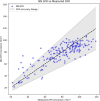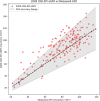A neural network approach to glomerular filtration rate estimation: a single-centre retrospective audit
- PMID: 40223657
- PMCID: PMC12136396
- DOI: 10.1097/MNM.0000000000001982
A neural network approach to glomerular filtration rate estimation: a single-centre retrospective audit
Abstract
Objectives: The 2009 Chronic Kidney Disease Epidemiology Collaboration (CKD-EPI) equation without race correction factor is frequently used for an estimate of glomerular filtration rate (eGFR) and to support a single-sample GFR regime. This study examines whether neural networks offer a potential means to improve the accuracy of GFR estimates using the same initial inputs as eGFR.
Methods: An audit of 865 adult GFR examinations and serum creatinine measurements between January 2010 and 2024 was undertaken. Patient sex, age, creatinine, and measured GFR were used to train a neural network (NN) model with an 80 : 20 train-test split, with test set root mean square error (RMSE), accuracy, median bias, and sensitivity calculated and compared against the 2009 CKD-EPI equation eGFR.
Results: NN GFR showed an improved performance against the 2009 CKD-EPI equation in RMSE: 12.0 vs. 16.6 mL/min/1.73 m 2 ( P < 0.001), median bias: -2.50 vs. 7.86 mL/min/1.73 m 2 ( P < 0.001) and accuracy: 94.2 vs. 83.2% ( P < 0.001). Both NN GFR and the eGFR equation had poor sensitivity across the British Nuclear Medicine Society single-sample ranges of 25-50, 50-70, 70-100, and >100 mL/min/1.73 m 2 : 57.9 vs. 57.9%, 50.0 vs. 26.9%, 84.4 vs. 54.2%, 10.0 vs. 70.0%.
Conclusion: This study has suggested that locally trained NNs can offer a potential avenue to improve GFR predictions, even on small and diverse datasets.
Advances in knowledge: Although the model is not sufficiently sensitive to predict the optimum time-sample point for a single-sample regime, this work can serve as a proof of concept for UK-specific NN GFR models.
Keywords: GFR; eGFR; glomerular filtration rate; machine learning; neural network.
Copyright © 2025 The Author(s). Published by Wolters Kluwer Health, Inc.
Conflict of interest statement
There are no conflicts of interest.
Figures






Similar articles
-
Performance of the 2021 Race-Free CKD-EPI Creatinine- and Cystatin C-Based Estimated GFR Equations Among Kidney Transplant Recipients.Am J Kidney Dis. 2022 Oct;80(4):462-472.e1. doi: 10.1053/j.ajkd.2022.03.014. Epub 2022 May 16. Am J Kidney Dis. 2022. PMID: 35588905
-
A back propagation neural network approach to estimate the glomerular filtration rate in an older population.BMC Geriatr. 2023 May 24;23(1):322. doi: 10.1186/s12877-023-04027-5. BMC Geriatr. 2023. PMID: 37226135 Free PMC article.
-
Estimation of GFR in South Asians: a study from the general population in Pakistan.Am J Kidney Dis. 2014 Jan;63(1):49-58. doi: 10.1053/j.ajkd.2013.07.023. Epub 2013 Sep 26. Am J Kidney Dis. 2014. PMID: 24074822 Free PMC article.
-
A more accurate method acquirement by a comparison of the prediction equations for estimating glomerular filtration rate in Chinese patients with obstructive nephropathy.BMC Nephrol. 2016 Oct 18;17(1):150. doi: 10.1186/s12882-016-0345-0. BMC Nephrol. 2016. PMID: 27756243 Free PMC article.
-
GFR estimation: from physiology to public health.Am J Kidney Dis. 2014 May;63(5):820-34. doi: 10.1053/j.ajkd.2013.12.006. Epub 2014 Jan 28. Am J Kidney Dis. 2014. PMID: 24485147 Free PMC article. Review.
References
-
- Murray AW, Barnfield MC, Waller ML, Telford T, Peters AM. Assessment of glomerular filtration rate measurement with plasma sampling: a technical review. J Nucl Med Technol 2013; 41:67–75. - PubMed
-
- Fleming JS, Nunan TO; British Nuclear Medicine Society. The new BNMS guidelines for measurement of glomerular filtration rate. Nucl Med Commun 2004; 25:755–757. - PubMed
-
- National Institute for Health and Care Excellence, NICE guideline [NG203] Chronic kidney disease: assessment and management. 2021. - PubMed
-
- Burniston M. Clinical guideline for the measurement of glomerular filtration rate (GFR) using plasma sampling. British Nuclear Medicine Society; 2018. - PubMed
MeSH terms
Substances
LinkOut - more resources
Full Text Sources
Research Materials
Miscellaneous

